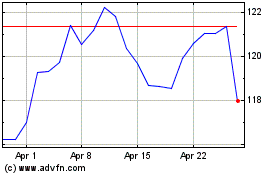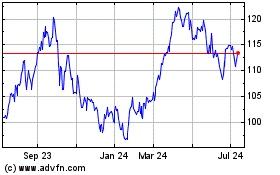ExxonMobil Announces 2016 Reserves
February 22 2017 - 4:30PM
Business Wire
Exxon Mobil Corporation (NYSE:XOM) announced today proved
reserves were 20 billion oil-equivalent barrels at year-end 2016,
inclusive of a net reduction of 3.3 billion oil-equivalent barrels
from 2015. Reserves changes in 2016 reflect new developments as
well as revisions and extensions to existing fields resulting from
drilling, studies, analysis of reservoir performance and
application of the methodology prescribed by the U.S. Securities
and Exchange Commission.
As a result of very low prices during 2016, certain quantities
of liquids and natural gas no longer qualified as proved reserves
under SEC guidelines.
These amounts included the entire 3.5 billion barrels of bitumen
at Kearl in Alberta, Canada. Another 800 million oil-equivalent
barrels in North America did not qualify as proved reserves, mainly
due to the acceleration of the projected economic end-of-field
life. These revisions are not expected to affect the operation of
the underlying projects or to alter the company’s outlook for
future production volumes. The reductions were partially offset by
reserves additions of oil and natural gas totaling approximately 1
billion barrels of oil equivalent in the U.S., Kazakhstan, Papua
New Guinea, Indonesia and Norway, which replaced 65 percent of
production and were the result of acquisitions, improved asset
performance and a decision to fund an expansion of the Tengiz
project in Kazakhstan.
Consistent with SEC requirements, ExxonMobil reports reserves
based on the average of the applicable market price prevailing on
the first day of each calendar month during the year. Prices to
date in 2017 have been higher than the average first-of-month
prices in 2016. Among the factors that would result in these
amounts being recognized again as proved reserves at some point in
the future are a recovery in average price levels, a further
decline in costs, and / or operating efficiencies.
The annual reporting of proved reserves is the product of the
corporation’s long-standing, rigorous process that ensures
consistency and management accountability in all reserves bookings.
Over the past 10 years, ExxonMobil has added proved oil and gas
reserves totaling approximately 13 billion oil-equivalent barrels,
including the impact of asset sales, replacing 82 percent of
produced volumes. ExxonMobil’s reserves life at current production
rates is 13 years. Liquids account for 53 percent of proved
reserves.
Resource Base
During 2016, ExxonMobil added nearly 2.5 billion oil-equivalent
barrels to its resource base through by-the-bit exploration
discoveries, undeveloped resource additions and strategic
acquisitions. The resource base includes proved reserves, plus
other discovered resources that are expected to be ultimately
recovered.
ExxonMobil’s by-the-bit exploration success in 2016 included
significant oil discoveries in Nigeria and Guyana. Strategic
unconventional resource additions were made in the Appalachian
Basin in Pennsylvania, the Permian Basin in West Texas and Neuquén
Province in Argentina.
Overall, the corporation’s resource base totaled more than 91
billion oil-equivalent barrels at year-end 2016, taking into
account field revisions, production and asset sales.
CAUTIONARY NOTE: Proved reserve figures in this release are
based on current SEC definitions. Reserves also include oil sands
and equity company reserves for all periods, which were excluded
from SEC reserves prior to 2009.
The terms “resources” and “resource base” include quantities of
discovered oil and gas that are not yet classified as proved
reserves but that are expected to be ultimately recovered in the
future. The term “resource base” is not intended to correspond to
SEC definitions such as “probable” or “possible” reserves.
The term “project” as used in this release does not necessarily
have the same meaning as in any government payment transparency
reports.
About ExxonMobil
ExxonMobil, the largest publicly traded international oil and
gas company, uses technology and innovation to help meet the
world’s growing energy needs. ExxonMobil holds an industry-leading
inventory of resources and is one of the largest integrated
refiners, marketer of petroleum products and chemical manufacturers
in the world. Follow ExxonMobil on Twitter at
www.twitter.com/exxonmobil.
View source
version on businesswire.com: http://www.businesswire.com/news/home/20170222006556/en/
ExxonMobilMedia Relations, 972-444-1107
Exxon Mobil (NYSE:XOM)
Historical Stock Chart
From Mar 2024 to Apr 2024

Exxon Mobil (NYSE:XOM)
Historical Stock Chart
From Apr 2023 to Apr 2024
